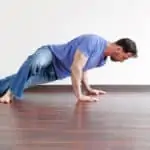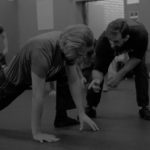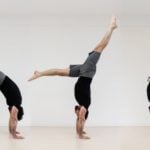We’ve all seen those videos of some guy in a gym doing overhead squats while standing on a Bosu ball.
That just doesn’t seem like a very good idea (anyone could easily slip and fall doing something like that). It’s almost as if the whole point is to make the exercise as complex as possible.
Complexity in training is valuable because it makes it possible to change variables in your training as much as you like. And it helps you discover new things about how your body moves and what you need to work on. But it can also be dangerous if introduced inappropriately.
In this article, we’ll talk about how complexity works (including 2 different types of complexity), and how to introduce complexity progressively (and safely).
Understanding the 2 Types of Complexity
Complexity does not mean a higher level of strength or mobility, but does often require a higher level of motor control. Complex movement is accessible at any level of skill, so long as it’s introduced in the right way.
There are two main types of complexity: mechanical complexity and motor complexity. In this video, Ryan will walk you through each of these types of complexity, and show you how they are distinct from one another:
Let’s take a quick look at the key points of mechanical and motor complexity:
1. Mechanical Complexity

The handstand stacks the whole body and is more mechanically complex than the crow pose.
When we talk about mechanics, we refer to body structure and how the pieces of the body work together.
Mechanical complexity, then, is when there are multiple parts of the body structure that you have to be aware of and control as you move.
So, as we saw in the video above, a handstand is more complex than a crow hold because you are relying on more joints to work together and stabilize your body.
When you increase complexity, it will be harder, but does not necessarily require a higher level of strength or mobility.
2. Motor Complexity

Play around with different angles within an exercise to add layers of motor complexity.
Here, complexity can be introduced by adding different vectors so your body moves in different directions or speeds, rather than in one plane of motion.
For instance, the bodyweight squat is normally practiced in an up-and-down motion. To make this simple movement more complex, you can rotate of your torso, shift your weight from side-to-side, or play with speeding up or slowing down your descent and/or ascent.
You can also take two movements that are within your capabilities and link them together (for instance, a squat with a backward roll).
Since both movements are within your current level of capabilities, you can see that complexity does not mean it’s more advanced, but rather involves more variables.
How to Introduce Complexity as a Training Variable
Let’s look a little more closely at complexity. We’ve seen that it’s not a matter of making your training “harder,” but rather adding layers to your training that aren’t possible in singular planes of motion.
But it’s also not a matter of “graduating” from beginner-level movements or skills and then adding complexity into the mix.
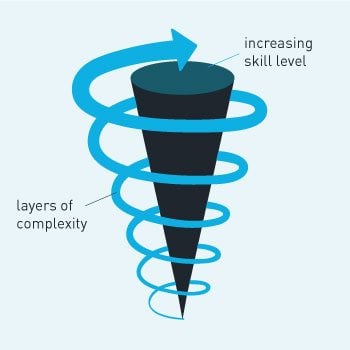 Think of an upward spiral.
Think of an upward spiral.
You may start with building basic capabilities, and then as you move upward, you may add layers of complexity into your training. But with each upward turn, you also gain more from those basics, and solidify them further.
That intertwined relationship between fundamental attributes, and greater complexity as you move up the spiral, combine to create whatever expression of movement you want.
But what are the components that make it easy and smooth to add mechanical and motor complexity into your training?
This is not a stepwise process, but the following components are necessary.
Build Basic Capabilities
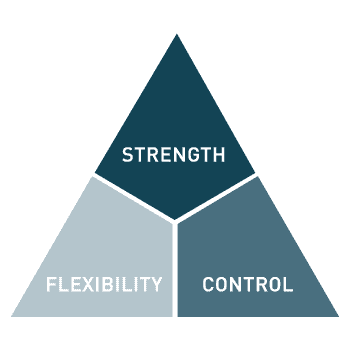
Build up the fundamental attributes you need for your physical skills.
We define “the basics” as the fundamental attributes that make up the movements and skills you want to master.
If we follow that spiral analogy above, you never stop gaining greater understanding of the basics, and you never stop improving them.
But you do have to start somewhere. If you haven’t begun to build your basic capabilities yet, then linking those together and chasing after complex movement may not be the right thing at this point.
Start by building your basics, then keep coming back to them.
Improve Your Weakest Link

If something feels tight or restricted in some other way, take some time to fix those weak links.
If you have weak links that make it difficult to explore and experiment with complex movement, you’d do well to address those.
You can work on your missing links exclusively for a time before experimenting with other ways of moving, or you can work on those areas while you explore the areas where you are comfortable.
For instance, if you have tight hips that hold you back from squatting with ease, you may not be ready to experiment with moving within the squat. Instead, you may play around with movements that emphasize your strong and mobile shoulders.
Play to your strengths, while working on your weaknesses.
Experiment with Complex Movements
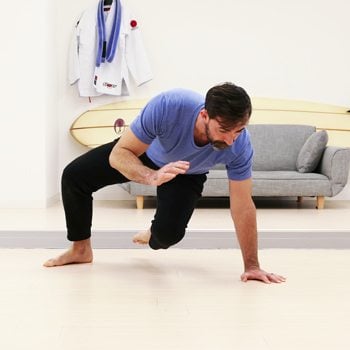
Start experimenting with different variables to add complex movement into your routine.
As you work on your basics and address your weak links, you can begin experimenting with complex movements at whatever level you are at.
Remember, making exercises more complex does not mean making them harder.
You can begin incorporating mechanical complexity by changing the vectors of a particular exercise, or you can work on motor complexity by linking two or more movements together. Either way, when you start experimenting within your level of comfort, you’ll discover new facets of movement, as well as different areas that may need more work.
- You may squat with a rotation and discover that your mid-back is quite tight and you need to work on some back stretches.
- You may be working on combining a monkey locomotion exercise with a bear walk, and feel that your wrists aren’t strong enough to keep up. Then you may add in some wrist strengthening exercises to your routine.
There are endless things you could discover through exploring complex movement.
You could find out that your shoulders are a lot stronger than you thought, and that you can use that shoulder strength to do more than you have been.
And you could find yourself reinvigorated to train by changing up your routine.
Add Rich Complexity to Your Training Routine
When you add new variables to your training, you open up so many more possibilities for yourself, and you can learn things about how your body moves that you just can’t with standard exercise.
The key is to add layers of complexity by working within your capability. With each layer you’ll gain more insight and ability.
Start Practicing Complex Movements
With Elements, we practice both mechanical complexity and motor complexity, and give you new movements to try each day.



